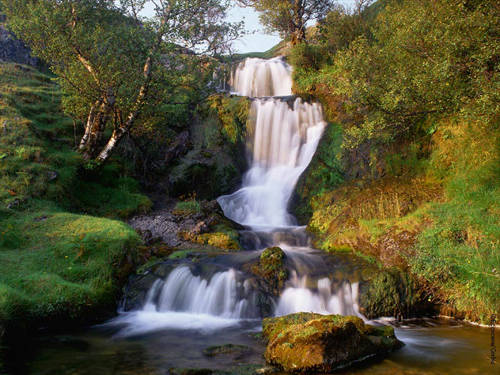|

|
|
Shennongjia Nature Reserve lies between the Yangtze and Hanjiang rivers, with 2,618 square kilometers of forest and beautiful scenery. [File photo]
|
Glorious past: Richer than other places
Shennongjia has had its own golden age. In 1959, the Chinese government announced the development of Shennongjia into the biggest timber production base in the mid-south region of China. Over 8,000 workers were subsequently sent there to build roads, 198 kilometers of which were completed in 1966. Mysterious Shennongjia was thereby exposed to the world's gaze.
In 1970, the cabinet approved the establishment of Shennongjia Forest District, under the charge of Hubei Province, and the target of local officials was to develop the forestry economy.
At that time, Chen Wei was a rich and honored lumberman, and his salary was 63 yuan per month, compared with a national average worker's salary of 35 yuan per month. Each day, Chen cut 3 to 4 trees with a diameter of 60 cm. It was his comparative wealth that attracted his wife to him.
During the ten years from 1970 to 1979, Shennongjia produced over 1 million cubic meters of timber and made a great contribution to the development of the country, while the forest cover of Shennongjia declined rapidly from 76.4 percent to 63.7 percent.
In 1982, Shennongjia Nature Reserve was established under the approval of Hubei provincial government and it was ranked as a state-level nature reserve by the State Council in 1986. Since then, Hubei has steadily reduced the timber production of Shennongjia. However, as there were no alternative industries here and the forestry industry was still very important to local development, the conflict between environmental protection and economic development was always sharp.
Plight caused by prohibition on felling trees
In April 1999 Wen Jiabao signed the order: "In terms of environmental security, the status of Shennongjia Forest District is so important that it should be brought under the natural forest protection system."
In March 2000, Shennongjia completely ceased the felling of natural forest and closed more than 80 forestry companies. The forest industry of Shennongjia came to an end.
Forest cover subsequently rose to 88 percent and snub-nosed monkey numbers, enjoying first-class state protection, increased to 1300. However, this was accompanied by such issues as a rapid decline of the local economy, large numbers of workers laid off from their jobs, a sharp drop in incomes, and social instability.
The same year, the provincial government held a special conference to discuss Shennongjia's issues and look for sustainable development opportunities, always taking environmental protection as the first priority.
In 2008, Shennongjia Forest District witnessed a substantial growth in GDP. Farmers' per capita net income increased by 16.8 percent to 3,330 yuan (US$487.6), and urban residents' per capita net income rose by 14.4 percent to 9,164 yuan (US$1341.9). However, compared with the national averages - 4,761 yuan and 15,781 yuan – they remain stubbornly low.
"Exploration indicates that there are over 20 different mineral resources in Shennongjia, consisting of phosphorite, agate and so on," says Xiang Changyou. "The total mineral value of the district could be more than 60 billion yuan, but as Shennongjia is a nature reserve, subject to numerous regulations, we can't exploit the local resources on an industrial scale. Therefore, we have no realistic prospect of further increasing GDP. "